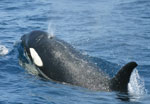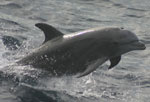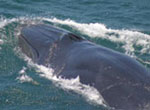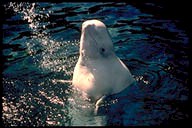Cetaceans: Whales, Dolphins, and Porpoises
Overview
Approximately 78 species of whales, dolphins, and porpoises are included in the Order Cetacea. Cetaceans are broken into two Suborders, or main groups, Mysticeti (baleen whales) and Odontoceti (toothed whales). There are 11 species of baleen whales and 67 species of toothed whales. Cetaceans are relatively large, generally characterized by streamlined bodies that glide easily through the marine environment.
Status of Cetacean Species
All cetaceans are protected under the Marine Mammal Protection Act (MMPA); some may be designated as "depleted" under the MMPA. Endangered and threatened cetaceans are further protected under the Endangered Species Act (ESA).
The table below includes cetaceans that have been designated as depleted under the MMPA, including, by default, ESA-listed cetaceans. For non-depleted cetaceans managed under the MMPA, please refer to the second list below.
(E = "endangered"; P = "proposed"; D = "depleted"; C = "candidate"; S = "species of concern"; DL = "delisted"; F = "foreign")
| Species | Status |
|---|---|
|
|
|
P/S/D |
|
E/D |
|
|
|
D |
|
E/D |
|
E/D (F) |
|
E/D |
|
|
|
E/D |
|
DL |
|
E/D (F) |
|
E/D |
|
E/D (F) |
|
|
|
E/D |
|
D |
|
E/D |
|
E/D |
|
E/D |
|
|
|
D |
|
|
|
D |
|
E/D (F) |
|
E/D |
Non-Depleted/Non-Candidate Cetaceans (MMPA)
Main factors for decline
Almost all species of baleen whales were exploited by the commercial whaling industry from the 1700s to the mid-1900s; most populations have not yet recovered. Currently, ship strikes pose a threat to many baleen whales, particularly the critically endangered North Atlantic right whale. Additionally, entanglement in various types of fishing gear is a primary threat to several species of cetaceans.
For More Information:
Kids' Whale Page
Fisheries Interactions Program
International Whaling Commission ![]()
Marine Mammal Stock Assessment Reports
NOAA Fisheries Northeast Region Protected Resources Division
Proposed Strategy to Reduce Ship Strikes to Right Whales
Right Whale Ship Strike Information






